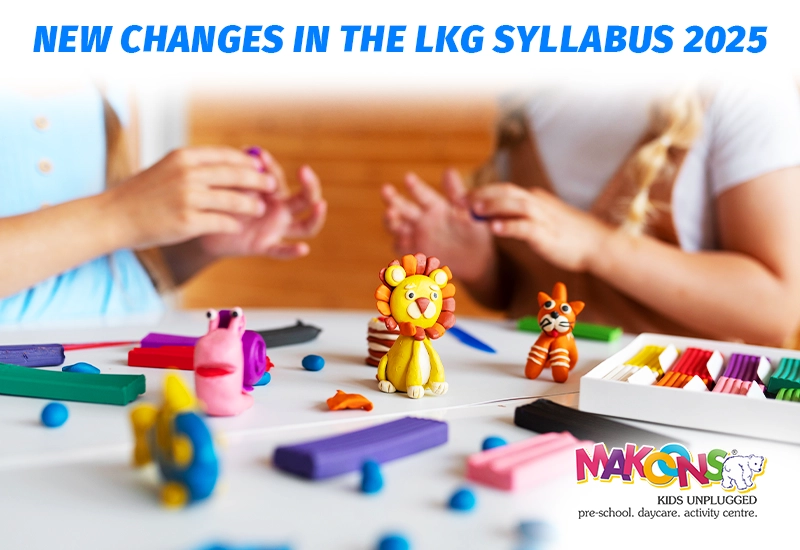A New Beginning in Tiny Classrooms
Something big is happening in India’s tiniest classrooms.
LKG is changing. And it’s not just a small update—it’s a full transformation.
Thanks to NEP 2020, the LKG syllabus 2025 is getting a major glow-up. Think less about memorizing ABCs and more about painting, singing, playing, and asking questions like, “Why do birds fly?” or “Where does rain go?”
Sounds refreshing, right?
Whether you’re a parent, teacher, or just someone who cares about the little learners—this blog is your quick and clear guide to what’s new in the preschool syllabus in India.
So, Why Change the LKG Syllabus at All?
Picture this:
A 4-year-old sitting with a pencil, copying alphabets again and again.
Looks studious, sure. But is that real learning?
Earlier, preschool focused too much on memory. Too little on meaning. Kids were expected to read, write, count—fast. Emotions? Play? Curiosity? Not always given space.
But research—and honestly, common sense—says otherwise.
NEP 2020 got it right.
Early childhood is not about marks. It’s about building brains.
That’s why NEP guidelines for preschool now put activity-based learning in LKG front and center.
The Core Ideas Behind the NEP 2020 LKG Changes
Let’s simplify. The new LKG education reforms stand on a few key pillars:
Whole-child approach: Physical, emotional, social, cognitive—everything matters.
Learning through play: Toys, games, music, drama—yes, even dancing counts.
Language love: Starting in the child’s home language makes learning stick.
Freedom and flexibility: No one-size-fits-all. Teachers can adapt.
Inclusivity: Every child, every ability, every background—belongs.
Now, these ideas aren’t just “nice to have.”
They’re baked into the new LKG syllabus 2025.
What’s Actually New in the LKG Curriculum (2025 Edition)?
Here’s the good stuff. What’s really different now?
- Themes, Not Subjects
Instead of chunks of Math, English, EVS—kids learn through themes like My Family, Colours Around Me, Animals, or Seasons. Everything connects. Like a story.
- Activities Everywhere
Say hello to activity-based learning in LKG. Clay modeling. Nature walks. Singing circles. Puppet plays. Sorting and matching.
Each topic has hands-on fun built right in. Because doing is learning.
- Play. And More Play.
Free play. Guided play. Group play.
NEP says—play isn’t break time, it is learning time.
Kids imagine. They explore. They fail. They try again. That’s real growth.
- Start With What They Know
Children first learn in their mother tongue or regional language. It feels natural. English comes later—through rhymes, storytelling, and fun.
- No Exams. Really.
The new LKG education reforms ditch tests and marks. Teachers observe. They watch how kids talk, move, think, share, build.
Progress is tracked through simple tools: journals, checklists, drawings.
- Yes, Even Digital and Nature Skills
The LKG syllabus 2025 touches on both—digital basics and environmental care. Kids plant seeds, recycle paper, talk about the planet.
They also learn to use devices safely (just a little, don’t worry!).
Okay, So What Should Parents & Schools Do?
👪 Parents:
Don’t push. Let kids play and ask questions.
Read stories together. Pretend-play is gold.
Talk. A lot. About clouds, butterflies, feelings, anything!
🏫 Schools:
Set up learning corners—art, books, blocks, pretend play.
Train teachers in child-led learning.
Keep class sizes small. Kids need attention. Not just instruction.
The Bigger Picture: What’s the Impact?
This is more than just curriculum updates.
The NEP guidelines for preschool are about changing how we see learning.
Here’s what we’re aiming for:
Kids who love to learn—not fear it
Children who are confident, curious, and kind
Smooth transitions to UKG and primary school
Less pressure. More wonder.
A stronger foundation for life—not just exams
That’s the promise of the new LKG curriculum.
Read More – Best LKG Schools in India for 2025
Final Thoughts: A Brighter Start
Change can feel scary. But this one? It’s worth celebrating.
The LKG syllabus 2025 is fresh, joyful, and deeply rooted in what children really need.
Let’s not resist it. Let’s lean into it. Because honestly?
When a 4-year-old walks into class excited to build, paint, imagine and share—that’s not just a “syllabus.” That’s a spark.
A spark that leads to lifelong learning.
And that’s magical.

